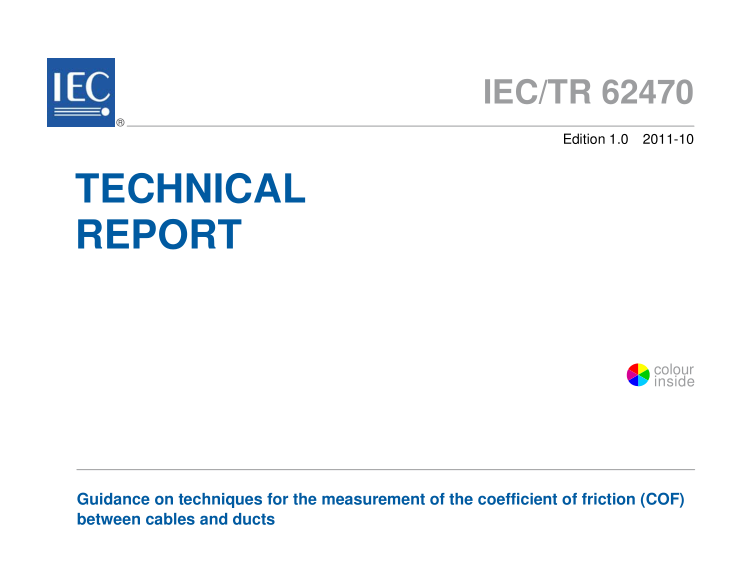IEC TR 62470:2011 pdfダウンロード

IEC TR 62470:2011 pdfダウンロード。Guidance on techniques for the measurement of the coefficient of friction (COF) between cables and ducts
1 Scope and object This technical report describes three techniques to measure the coefficient of friction (COF) between cables and ducts. For a given technique, cable construction, installation method (pulling, pushing, or blowing), and duct size, the relative values of the COF can give some indication as to the relative ease of installation. The techniques can be used for traditional cables and ducts (see IEC 60794-3-1 0) as well as for microduct cables and microducts (see IEC 60794-5). A fibre or fibre unit may be evaluated in place of a cable in all techniques. Methods A, B, and C are distinguished by the equipment used for measurements:
• method A – using a wheel around which the duct is wound, a cable with attached weight being pulled through the latter, while measuring the force needed for this;
• method B – using a device to clamp a duct specimen, a cable specimen placed inside, tilting both while measuring the angle at which the cable specimen starts to slide, or the angle which sustains sliding; and
• method C – using a device to clamp and straighten a cable specimen, a duct specimen placed around it, tilting both while measuring the angle at which the duct specimen starts to slide, or the angle which sustains sliding. The COF when the cable is not moving with respect to the duct is the static COF, and will increase until sliding suddenly starts. The COF while the cable is sliding within the duct is the kinetic or dynamic COF. It should be noted that the static COF will generally be a higher value than the kinetic COF. The results from the three methods can be compared qualitatively, but are not represented as being equivalent. None of the methods are represented as being the Reference Test Method. Method A will yield the kinetic COF; methods B and C will yield both static and kinetic COF. Both the static and kinetic COF may be dramatically affected by lubrication of the cable and/or duct. While not specifically addressed herein, the intent of these methods may be used with lubricated cable/duct samples.
These methods do not constitute a routine test used in the general evaluation of the installation performance of cables in ducts. This parameter is not generally specified within a detail specification.
2 Reference documents
The following referenced documents are indispensable for the application of this document. For dated references, only the edition cited applies. For undated references, the latest edition of the referenced documents (including any amendments) applies. IEC 60794-1 -1 :2001 , Optical fibre cables – Part 1-1: Generic specification – General
IEC 60794-3-1 0: Optical fibre cables – Part 3-10: Outdoor cables – Family specification for duct, directly buried and lashed aerial optical telecommunication cables
IEC 60794-5: Optical fibre cables – Part 5: Sectional specification – Microduct cabling for installation by blowing
- Previous:IEC TR 62422:2007 pdfダウンロード
- Next:IEC TR 62482:2008 pdfダウンロード